Definition : When elements are arranged in increasing order of their standard reduction electrode potentials, the series so obtained is known as electrochemical (or) electromotive series.
or
A series in which standard reduction potentials of various electrodes are arranged in the order of increasing reduction potentials (largest reduction potential at the top) or decreasing oxidation potential is known as electrochemical series.
Important characteristics of electrochemical series
- Active metals occupy the top of the series.
- If the reduction potential is more negative, the metal will displace other metals from their salts more reactively.
- Metals near the top of the series are strongly electropositive and lose electrons readily to give cations, i.e., they are readily oxidised. Hence, they are good oxidising agents.
- Elements at the bottom of the series are highly electronegative and gain electron readily to form anions, i.e., they are readily reduced. Hence, they are good oxidising agents.
- Metals above hydrogen in the series displace hydrogen from dilute acids.
| Electrode | Electrode reaction (reduction) | E° Reduction (Volt) |
| Li+ / Li | Li + e |
-3.045 |
| Ca2+ / Ca | Ca2+ + 2e– |
-2.87 |
| Mg2+ / Mg | Mg2+ + 2e– |
-2.37 |
| Zn2+ / Zn | Zn2+ + 2e– |
-0.763 |
| Fe2+ / Fe | Fe2+ + 2e– |
-0.440 |
| Sn2+ / Sn | Sn2+ + 2e– |
-0.136 |
| 2H+ / H2; Pt | 2H+ + 2e– |
±0.00 |
| Sn4+ / Sn2+ | Sn4+ + 2e– |
+0.15 |
| Cu2+ / Cu | Cu2+ + 2e– |
+0.337 |
| Fe3+ / Fe2+ | Fe3+ + e– |
+0.771 |
| Ag+ / Ag | Ag2 + e– |
+0.779 |
| I2 / 2l– | I2 (s) + 2e– |
+0.530 |
| Br2 / 2Br– | Br2 (s) + 2e– |
+1.060 |
| Cl2 / 2Cl– | Cl2 (g) + 2e– |
+1.360 |
| F2 / 2F– | F2 (g) + 2e– |
+2.87 |
Applications of electrochemical series
Electrochemical series find many applications. A few of them is given below to appreciate the immense importance of this series.
(i) Calculation of emf of a cell
The electrochemical series is very helpful in determining the emf of a cell.
Ecell = E°cathode – E° anode
Eg.,
Consider a galvanic cell consisting of zinc and copper; zinc being anode. The standard reduction potentials of zinc and copper are −0.76°V and +0.34°V, respectively. therefore, emf of the cell is given by
Ecell = E°cathode -E°anode
= 0.34 – (-0.76)
= 1.10°V
(ii) Predicting the feasibility or spontaneity of a redox reaction
The electrochemical series enables us to predict whether a particular redox reaction is possible or not
Eg.,
In general, a redox reaction can occur if the species losing the electrons lies above that of species which gains the electrons in the electrochemical series.
In a reversible cell, when the cell yields electrical energy, there is a fall in free energy
-ΔG = nFE.
(a) If ΔG= negative; E= positive. Then the cell reaction is feasible or spontaneous.
(b) If ΔG= positive; E= negative. Then the cell reaction is nonspontaneous or not feasible.
(c) If ΔG=0; E=0. Then, the cell reaction has the equilibrium.
(iii) Displacement of metal or element
If a metal or element lies higher in electrochemical series, it can displace another metal from its solution lying below it in electrochemical series.
Eg.,
Iron lies above copper in electrochemical series. So iron can displace copper from copper sulphate solution.
Fe +CuSO4 → Cu + FeSO4
(iv) Displacement of hydrogen from acids
Only those metals which lie above hydrogen in electrochemical series can displace hydrogen from dilute acids.
Eg.,
Zinc lies above hydrogen in electrochemical series. Therefore, it can displace hydrogen from dilute acids.
Zn+ H2SO4 → ZnSO4 + H2 Ezn = 0.76V
Metals like copper and silver lie below hydrogen in electrochemical series and cannot displace hydrogen from acids.
Ag+ H2SO4 → no reaction EAg =+0.80V
(v) Oxidising and reducing agents
In electrochemical series, the elements are arranged in the order of increasing reduction potentials.
Therefore, the elements at the top of series lose their electrons easily and are, therefore, strong reducing agents.
It easily undergoes reduction while it is difficult to oxidise. The elements at the bottom of the series gain electrons easily and are strong oxidising agents.
Eg.,
Lithium has the largest reduction potential. It means that it is difficult to reduce Li+ ions to Li. On the other hand, it will be most easy for Li to get oxidised to Li+ ions.
(vi) Determination of equilibrium constant for the reaction
Standard electrode potential can be used to determine equilibrium constant for the reaction.
We know that,
-ΔG° = RT lnK = 2.303 RT logK
logK = -ΔG°
So by knowing E° for a cell reaction, its equilibrium constant can be calculated.
| Read More Topics |
| Nernst Equation |
| Measurement of single electrode potential |
| Definition and origin of electrode potential |






